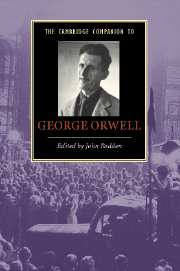Book contents
- Frontmatter
- 1 A political writer
- 2 Orwell and the biographers
- 3 Englands His Englands
- 4 The truths of experience: Orwell’s nonfiction of the 1930s
- 5 The fictional realist: novels of the 1930s
- 6 Orwell’s essays as a literary experience
- 7 ‘My country, right or left’: Orwell’s patriotism
- 8 Orwell and the British Left
- 9 Orwell, anti-Semitism and the Holocaust
- 10 Orwell, Socialism and the Cold War
- 11 Animal Farm: history as fable
- 12 Nineteen Eighty-Four: context and controversy
- 13 Orwell, the academy and the intellectuals
- 14 Orwell for today’s reader: an open letter
- 15 George Orwell: a bibliographic essay
- 16 Why Orwell still matters
- Further reading
- Index
5 - The fictional realist: novels of the 1930s
Published online by Cambridge University Press: 28 July 2007
- Frontmatter
- 1 A political writer
- 2 Orwell and the biographers
- 3 Englands His Englands
- 4 The truths of experience: Orwell’s nonfiction of the 1930s
- 5 The fictional realist: novels of the 1930s
- 6 Orwell’s essays as a literary experience
- 7 ‘My country, right or left’: Orwell’s patriotism
- 8 Orwell and the British Left
- 9 Orwell, anti-Semitism and the Holocaust
- 10 Orwell, Socialism and the Cold War
- 11 Animal Farm: history as fable
- 12 Nineteen Eighty-Four: context and controversy
- 13 Orwell, the academy and the intellectuals
- 14 Orwell for today’s reader: an open letter
- 15 George Orwell: a bibliographic essay
- 16 Why Orwell still matters
- Further reading
- Index
Summary
George Orwell's four novels of the 1930s could only have been written in that decade. As he left them behind, he often wondered how they could have been written at all. Orwell composed the books - Burmese Days (1934), A Clergyman's Daughter (1935), Keep the Aspidistra Flying (1936) and Coming Up for Air (1939) - with an intense consciousness that he was writing after the heady days of modernism and beneath its shadow. At the same time he never allowed himself to forget the degraded social reality that surrounded his literary work, a recognition of imminent catastrophe. This double sense - literary belatedness, social emergency - pervades the novels. It accompanies a third condition, which is simply Orwell's conviction that novel-writing should be his vocation. This point should not be taken for granted. Orwell holds to his vocation despite the fact that his early fictions continually failed, especially in his own estimation, and that he had a successful parallel career as a documentary journalist. The book-length journalism of the 1930s - Down and Out in Paris and London (1933), The Road to Wigan Pier (1937) and Homage to Catalonia (1938) - has had a far more prominent afterlife than the fiction, and the first two of these books gained significant recognition when they first appeared. Yet Orwell continued to write novels in the face of his failure, or at best quite limited success.
- Type
- Chapter
- Information
- The Cambridge Companion to George Orwell , pp. 59 - 75Publisher: Cambridge University PressPrint publication year: 2007
- 4
- Cited by

